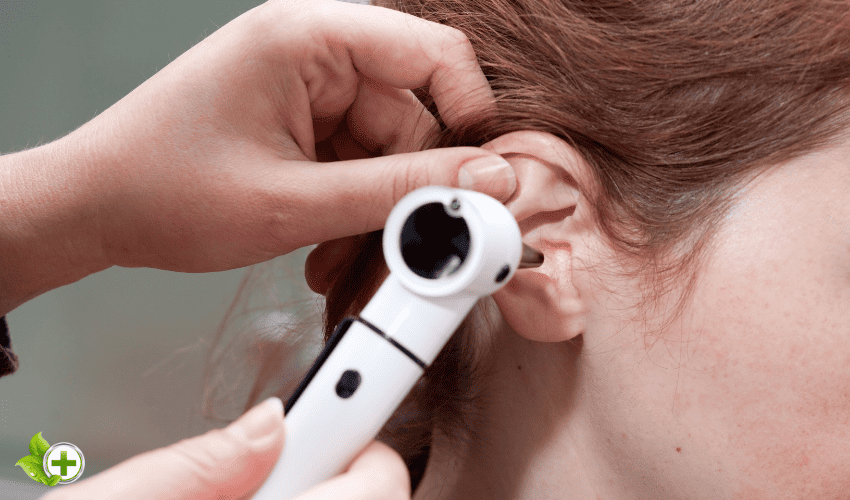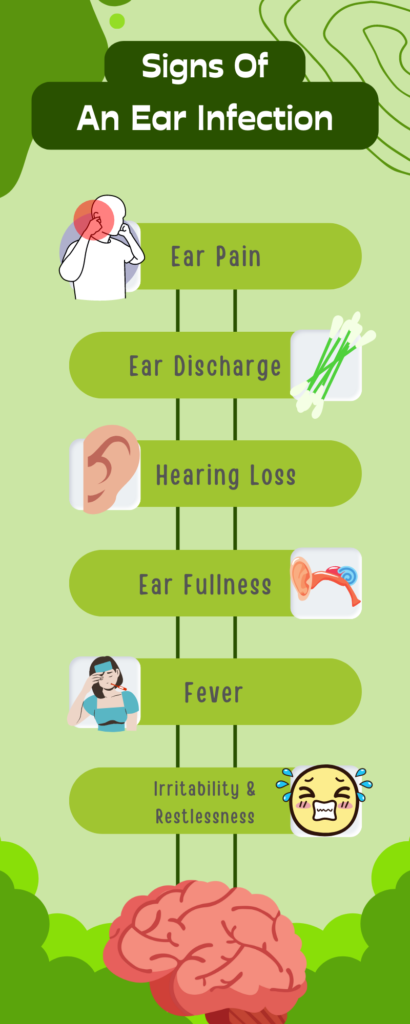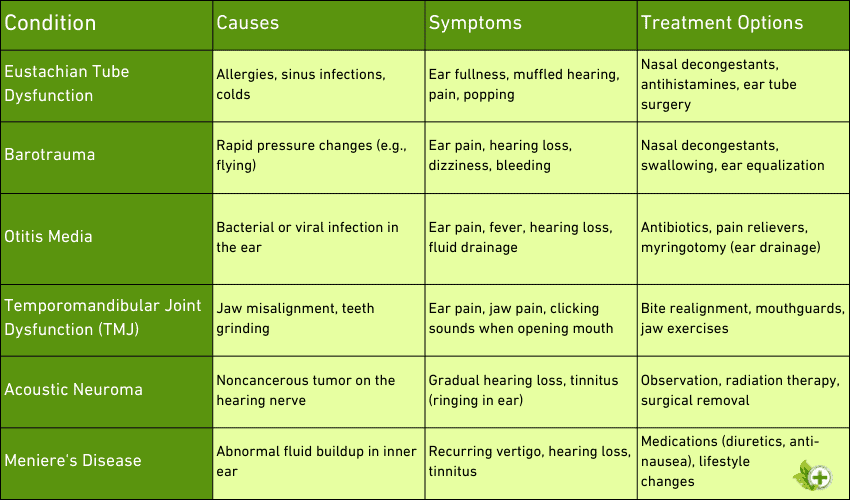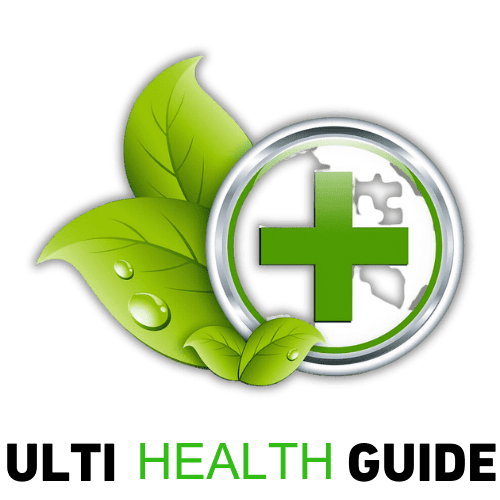Quick Reference
What Is Ear Pressure?
Ear pressure is the feeling of stuffyness and fullness that some people experience in their ears. It's often described as a "plugged-up" feeling, and it's most commonly caused by changes in air pressure.
What Causes Ear Pressure?
- Clog In The Eustachian Tube
- Swimmer's Ear
- Blocked Sinuses
What is Ear Barotrauma?
Ear barotrauma is the medical terminology for all ear-related discomfort or pain.
What Are The Symptoms of Ear Barotrauma?
- Feeling pressure in your ear
- Dizziness
- Severe ear pain
- Bleeding in the ears
- Ringing in your ears
- Hearing loss
What Causes Ear Barotrauma?
Ear barotrauma is caused by the eustachian tubes failing to open, or they are blocked and therefore they do not function properly. The air pressure on the middle ear side of your eardrum cannot be equalized to the air pressure on the outer ear side of your eardrum.
Three 'Quick Cures':
- Chew Gum
- Suck on boiled sweets
- Use a humidifier.


- Organic Ear Oil for Ear Infections All Natural Eardrops for Infection Prevention Swimmer's Ear and Wax Removal - Kids Adults Baby Dog Earache Remedy - with Mullein, Garlic | Marie Originals (2 Pack)

- SmartSweets Variety Pack, Candy With Low Sugar & Calorie, Healthy Snacks For Kids & Adults - Sweet Fish, Sourmelon Bites, Peach Rings, Sour Blast Buddies, 1.8oz (Pack of 8)

- PUR Gum | Sugar Free Chewing Gum | 100% Xylitol | Vegan, Aspartame Free, Gluten Free & Diabetic Friendly | Natural Bubblegum Flavored Gum, 55 Pieces (Pack of 6)
What is 'ear pressure '? Ear Pressure or the feeling of ear fullness is caused by a pressure difference on the eardrum which separates the middle ear from the external ear.
It is normally temporary and can be treated with over-the-counter medication. However, if the difference in air pressure is great and for whatever reason, the Eustachian tube does not open and balance out the pressure on the eardrum, this can result in serious damage or ear barotrauma to the eardrum and possibly permanent hearing loss.
There are three 'quick cures ' you can try to relieve ear pressure.
- Chew Gum.
- Suck on boiled sweets. This creates saliva which you swallow. Swallowing relieves your ear pressure.
- Use a humidifier. We recommend trying LEVOIT Humidifiers.

What Causes Ear Pressure?
There are 3 main parts to the human ear. The outer ear, the middle, and the inner ear. The outer ear is separated from the middle ear by the eardrum. Except for the 'ossicles', or the hearing bones in the middle ear, the middle ear, or tympanic cavity is essentially just a pressurized air-filled cavity behind the eardrum.
Imagine the middle ear as a box with a number of holes in it. In the roof of this box are holes that contain three bones, the three smallest bones in the human body. These sound bones namely the Hammer (malleus), are attached to the eardrum while the Anvil (incus) sits in the middle of the chain of bones and the Stirrup (stapes) carries the vibrations to the inner ear and to the brain.
In the wall of the box that is closest to the ear canal is the tympanic membrane (aka the eardrum). This membrane, which is approximately 1 mm thick and 8 or 10 mm in diameter, separates the middle ear from the outer ear canal and is held in position in the ear canal by air pressure from both the outer ear and the middle ear. [3]
The eustachian tube is positioned on the floor of the box and this leads to the nasal cavity in the back of the throat.
Normally in our everyday lives, the air pressure on the external side of the eardrum is equalized by the pressure on the middle ear side of the eardrum and there is no discomfort or pain associated with a difference in ear pressure.
Ear pressure happens when the air pressure on one side of your eardrum (normally the middle ear side) is no longer equal to the pressure on the other side (the outer ear side) of your eardrum. A change in your physical altitude is the most likely cause or reason why the air pressure in your outer ear would change.
We all know and understand the correlation between altitude and air pressure. The higher we go, as in when flying in an aircraft, the lower the atmospheric air pressure and consequently the lower the ear pressure on the outer wall of our eardrum.
Modern aircraft come with pressurized passenger cabins which go a long way in alleviating the ear pain or discomfort adults or teenagers would otherwise feel while flying.
Even in a pressurized environment, the middle and inner ear mechanisms of young children and babies are so sensitive that they will still be affected by the change in air pressure on their eardrums and this can cause them severe ear pressure, pain, and discomfort during the flight.
As a way of mitigating the child's pain and discomfort mothers flying with young children or babies know to have a dummy, a teat, or a lollipop handy for the child or baby to suck on during the flight. Especially during take-off and landing.
Nowadays, it is customary for many airlines to hand out boiled sweets for their passengers to suck on before take-off or landing. Sucking on sweets or chewing gum encourages frequent swallowing. Swallowing or yawning is a very positive way of getting your ears to 'pop' which equalizes the ear pressure on the eardrums.
This 'popping' action will relieve pressure and alleviate any uncomfortable feelings of ear fullness or ear pressure.
Conversely, the lower we go in altitude, as in scuba diving or landing in an airplane, the greater the atmospheric air pressure and consequently the greater the ear pressure on the outer ear wall of the eardrum.
If the middle ear does not equalize this greater external pressure the scuba diver will feel the pain and discomfort associated with ear pressure. Before plunging into the water scuba divers will often hold their noses and blow hard to clear their ears.
As in flying, popping, or clearing the ears before diving will equalize middle ear pressure and negates the pain and discomfort associated with out-of-balance ear pressure.
The eustachian tube
The Eustachian tube is a small tube that connects the middle ear to the nasopharynx which is located in the upper throat and the nasal cavity. Its primary function is to take in or release air from the middle ear cavity and to equalize the pressure on the middle ear side of the eardrum, thereby preventing ear fullness and damage to the eardrum.
It also serves as a drain to carry away any fluid or mucus that may accumulate in the middle ear cavity from a middle ear infection. But instead of flowing down the tube into the throat the mucus becomes trapped in the middle ear and clogs the tube.
To prevent ear middle ear infections it is important to keep the eustachian tube clear at all times.
Swimmer's ear
Another likely cause of an infection in the middle ear is water. When, after swimming, water remains in the ear it can cause an infection. Commonly known as swimmer's ear the moist environment encourages the growth of bacterial infection in the ear canal.
Factors that cause inflammation or fluid build-up around the eustachian tube and prevent it from operating properly include:-
- Allergies or irritants caused by repetitive loud noises
- Anatomical abnormalities like coughing, sneezing, or sore throat. And if you're struggling with a sore throat, we recommend consuming ginger; Get The Best Organic Ginger.
- Having a cold or flu
- Water in the ear
- Sinus congestion [2]
Blocked sinuses
Your sinuses are tiny air-filled cavities behind your nose, cheeks, and forehead. When these become blocked with mucus normally produced as a result of some bacterial infection or allergy they will put pressure on your middle ear giving you the sensation of ear fullness or ear pressure.
To relieve sinus congestion you can try, but if you're not sure you have sinus congestion you can read up on the symptoms.
- Using a humidifier.
- Rinse out your nasal passages with a weak saline drip
- Use a decongestant nasal spray
- Take antibiotics
- If your blockage persists, for longer than a week, see your doctor [3]

Signs of an ear infection
Signs that you may have an ear infection include:
- Ear Pain
- Redness of the ear
- Signs of fluid discharge on your pillow while sleeping at night
- Fever
What is ear barotrauma?
Ear barotrauma is the medical terminology for all ear-related discomfort or pain. This can range from temporary ear pressure or ear fullness to permanent hearing loss and ear surgery.
What are the symptoms of ear barotrauma?
The most common symptoms are:
- Feeling pressure in your ear
- Dizziness
- Severe ear pain
- Bleeding in the ears
- Ringing in your ears
- Hearing loss
Severe symptoms of ear barotrauma are often mistaken as symptoms of other health issues. If after a flight or a day of scuba diving you feel any ear pain, fullness of the ear, or experience any fungal ear infections it is best to consult with your doctor. Let him advise you on the need to be medically reviewed by an ear nose and throat specialist. [4]
What causes ear barotrauma?

Ear barotrauma is caused by the same reasons that ear pressure is caused. Only in the case of ear barotrauma, the eustachian tubes fail to open or they are blocked and therefore they do not function properly and the air pressure on the middle ear side of your eardrum cannot be equalized to the air pressure on the outer ear side of your eardrum.
This uncorrected difference in air pressure can severely damage the eardrum and often results in bleeding in the ear and possibly some degree of permanent hearing loss.
Severe ear barotrauma can also result from a sinus infection or sinus congestion which may require surgery to repair. An ear throat and nose specialist will advise you on the best treatment for your ear barotrauma.
Getting a good night's sleep is important for ear pressure relief.
Questions and Answers
Why Am I Feeling Ear Pressure?
There are many possible causes of pressure in your ears. The most common is the pressure in your middle ear has not normalized after a change in altitude, eg after your flight landed. You may have a mild sinus infection or even excessive ear wax build-up.
What Relieves Ear Pressure?
You can try several quick cures to relieve ear pressure; chewing gum, sucking on boiled sweets, and using a humidifier.

